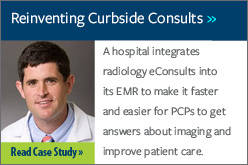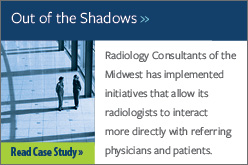Editor’s note: The following article first appeared in the JACR: “Appropriateness, Scheduling, and Patient Preparation,” Boland, Giles W. et al. Journal of the American College of Radiology, volume 11, issue 3, 225–226. Additional content is provided here with the goal of connecting the concepts with ACR tools and resources.
In the first article in this series, the concept of the imaging value chain was introduced and outlined, which starts with an imaging request and ends when a meaningful and actionable report is delivered. Each link in the chain represents a discrete value opportunity activity. In this article, we discuss the first 3 of those unique value activities: (1) the generation of an imaging request, (2) the scheduling of that request, and (3) the presentation of the patient to the imaging department. Practical solutions to optimizing each value activity are presented that maximize appropriateness, quality, safety, efficiency, and patient satisfaction.
The Challenge
 Imaging offers unique opportunities to detect, characterize, treat, and monitor disease given the increasing array of imaging tools and protocols available. Although few would disagree that the widespread use of imaging has been transformational to patient care, it has placed imaging increasingly in the spotlight for the wrong reasons, namely, too many unnecessary tests are being performed, with some asserting that as many as a third of such examinations may be inappropriate [1]. If these tests had no costs (financial or otherwise), perhaps this would not matter, but the overall costs are in fact profound. Every imaging test carries a cost, whether it is time, money, anxiety, or safety. When performed for the right reasons, most caregivers and patients would accept these costs as justifiable. On the other hand, an unnecessary or inappropriate test adds little or no value by inserting increased waste and cost into the value chain, decreasing the opportunity to deliver better outcomes. Ultimate value in radiology is created when there is the timely delivery to a requesting physician of meaningful and actionable information; an inappropriate imaging test, by definition, rarely does.
Imaging offers unique opportunities to detect, characterize, treat, and monitor disease given the increasing array of imaging tools and protocols available. Although few would disagree that the widespread use of imaging has been transformational to patient care, it has placed imaging increasingly in the spotlight for the wrong reasons, namely, too many unnecessary tests are being performed, with some asserting that as many as a third of such examinations may be inappropriate [1]. If these tests had no costs (financial or otherwise), perhaps this would not matter, but the overall costs are in fact profound. Every imaging test carries a cost, whether it is time, money, anxiety, or safety. When performed for the right reasons, most caregivers and patients would accept these costs as justifiable. On the other hand, an unnecessary or inappropriate test adds little or no value by inserting increased waste and cost into the value chain, decreasing the opportunity to deliver better outcomes. Ultimate value in radiology is created when there is the timely delivery to a requesting physician of meaningful and actionable information; an inappropriate imaging test, by definition, rarely does.
Most radiologists are familiar with this dynamic: the tension between offering an imaging test that might provide value and advocating for testing only when it is recognized as appropriate. In an attempt to provide support and guidance to providers caught in this dilemma, the ACR introduced the ACR Appropriateness Criteria®, which offer a comprehensive algorithmic approach to guide both referring physicians and radiologists alike to request the right test for the right patient at the right time. Composed by a combination of leading experts within both the radiology and clinical communities, the Appropriateness Criteria use the best available evidence, toward the ultimate goal of delivering the optimal actionable information.
Yet many radiologists and referring physicians still do not consistently follow and adhere to these recommendations, perhaps because they are guidelines, not mandates, leaving providers with considerable discretion as to whether to follow them or not.
Furthermore, even with the best intentions, most providers cannot consistently adhere to the gamut of recommendations, either because there are too many variables (eg, which test for which disease at which time) or because using them in their current format is simply too cumbersome and time consuming. Some might argue that radiologists should take whatever time is necessary to ensure universal imaging appropriateness, but this is simply neither practical nor reasonable. The complexities of implementing and managing a reproducible and standardized system across a health enterprise are numerous. Although many radiologists diligently attempt to discuss appropriate utilization with referrers when the test indications are dubious, the process is inefficient, disruptive, and occasionally confrontational. In short, it is simply impossible with most current workflows to implement and manage a seamless, point-of-care, reproducible, evidence-based, and consensus-driven algorithm that ensures that most patients will receive the right test at the right time. Consequently, overutilization and inappropriate utilization are prevalent and frequently poorly managed. Payers have taken notice, often resorting to image precertification filters (ie, radiology benefit managers), a process considered frustrating and inefficient by many and one that may result in as much cost shifting as cost savings [2].
The Solution
Given the challenges outlined above, it is likely that only the use of electronic clinical decision support (CDS) systems embedded into computerized physician order entry software will best maximize imaging appropriateness and minimize waste. Decision support is not new to medicine, and as computerized order entry becomes increasingly prevalent in electronic health records, opportunities for synergy abound. Imaging CDS systems offer the opportunity to implement best practices consistently [3, 4, 5, 6]. When CDS is embedded into electronic health records, a requesting physician at the point of care (often with the patient present) requests an examination by navigating through the decision support algorithm using imputed clinical symptoms and signs. A weighting score can be assigned according to the likelihood that the request will yield meaningful information, and if not, alternative options (or no test at all) are provided. Furthermore, because CDS is embedded into the electronic health record, relative or absolute contraindications can all be identified at the point of care, further optimizing appropriate examination selection and modality throughput efficiency.
Meanwhile, all data entry is archived and therefore minable either for compliance and quality reporting purposes or for multi-institutional “big-data” outcomes analysis. Recent reports have documented high levels of physician acceptance and satisfaction with CDS, as it simultaneously serves as an educational tool while often obviating the cumbersome precertification process; some third-party payers have accepted CDS systems in lieu of radiology benefit managers for determining imaging appropriateness [2]. Although CDS tools do not completely obviate the need for appropriate direct interaction between radiologists and referring physicians, they can direct an organization toward greater imaging appropriateness, patient quality, safety, and satisfaction while optimizing organizational efficiency.
The Patient Experience
 Once examination requests have been approved, patients should be adequately informed about their upcoming tests. Patients can be also be informed that radiologists, as physicians, will interpret their images and are also essential to their overall care and safety [7]. Patients should be encouraged to visit patient-focused imaging websites such as RadiologyInfo.org, which explains how various procedures are performed, what they might experience, and how they may prepare for the examinations. Further information also contributes positively to the overall patient experience, including directions, parking, and way finding. Patient reminders should be implemented to minimize no-shows, thus ensuring that equipment is used to maximal efficiency. Patients can also be offered access to online scheduling templates, permitting them to make changes should they wish.
Once examination requests have been approved, patients should be adequately informed about their upcoming tests. Patients can be also be informed that radiologists, as physicians, will interpret their images and are also essential to their overall care and safety [7]. Patients should be encouraged to visit patient-focused imaging websites such as RadiologyInfo.org, which explains how various procedures are performed, what they might experience, and how they may prepare for the examinations. Further information also contributes positively to the overall patient experience, including directions, parking, and way finding. Patient reminders should be implemented to minimize no-shows, thus ensuring that equipment is used to maximal efficiency. Patients can also be offered access to online scheduling templates, permitting them to make changes should they wish.
Once a patient arrives at the scheduled scanner location, it is intuitive—but often overlooked—that every team member (eg, receptionist, technologist, radiologist) has an opportunity to enhance patient engagement. Patients deserve to be informed immediately about any anticipated delays; greater transparency usually translates into greater patient satisfaction. Some organizations have successfully incorporated patient greeters and facilitators, ensuring that patients are informed of each step in their care process. Patient-centric radiologists are also increasingly integrating themselves into the workflow beyond their traditional interpretive role to enable patients to ask pertinent questions germane to radiologists' knowledge and experience. All such measures contribute to optimizing the patient experience and compliance at the imaging suite.
Conclusions
An imaging examination unnecessarily performed or with marginal benefit adds increased cost and waste into the overall care process, minimizing quality, safety, efficiency, and patient satisfaction, all detractors to enhanced value and overall patient outcomes. Ultimately, only through the integration of meaningful informatics and increased patient-centricity will imaging outcomes be optimized. Health systems in which radiologists advocate for these processes will most likely be the ones that provide the highest value and outcomes to patients.
The next article in the series will discuss imaging protocol design and optimization.
Value Chain Series
- Delivery of Appropriateness, Quality, Safety, Efficiency and Patient Satisfaction
- Appropriateness, Scheduling, and Patient Preparation
- Protocol Design and Optimization
- Optimizing Modality Operations
- Actionable Reporting
- Communication of Actionable Information
- Business Intelligence, Data Mining, and Future Trends
Related Resources
References
- D.J. Brenner, E.J. HallComputed tomography—an increasing source of radiation exposure, N Engl J Med, 357 (2007), pp. 2277-2284
- R. Duszak, J.W. BerlinUtilization management in radiology, part 1: rationale, history, and current status, J Am Coll Radiol, 9 (2012), pp. 694-699
- C.L. Sistrom, P.A. Dang, J.B. Weilburg, et al. Effect of computerized order entry with integrated decision support on the growth of outpatient procedure volumes: seven-year time series analysis, Radiology, 251 (2009), pp. 147-155
- C.G. Blackmore, R.S. Mecklenburg, G.S. Kaplan Effectiveness of clinical decision support in controlling inappropriate imaging J Am Coll Radiol, 8 (2011), pp. 19-25
- H.M. Zafar, A.M. Mills, R. Khorasani, C.P. LanglotzClinical decision support for imaging in the era of the Patient Protection and Affordable Care Act J Am Coll Radiol, 9 (2012), pp. 907-918
- I.K. Ip, L.I. Schneider, R. Hanson, et al.Adoption and meaningful use of computerized physician order entry with an integrated clinical decision support system for radiology: ten-year analysis in an urban teaching hospital J Am Coll Radiol, 9 (2012), pp. 129-136
- P. Miller, R. Gunderman, J. Lightburn, D. MillerEnhancing patients' experiences in radiology: through patient-radiologist interaction Acad Radiol, 20 (2013), pp. 778-781